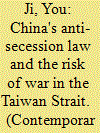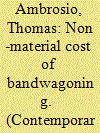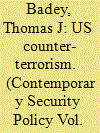|
|
|
Sort Order |
|
|
|
Items / Page
|
|
|
|
|
|
|
| Srl | Item |
| 1 |
ID:
072887


|
|
|
|
|
| Publication |
2006.
|
| Summary/Abstract |
The product of a ten-year debate, China's Anti-Secession Law assures Taiwan and the world that peaceful independence is a myth. The law explains that China is building military superiority to prevent Taiwan's de jure independence. This threat is matched by peace inducements, mainly economic integration, to increase the cost of independence. The ASL channels hard and soft approaches into one legal framework. Yet to this author, the ASL is fundamentally not a piece of law but a statement of Hu Jintao's new thinking. It enriches China's Taiwan policy of maintaining peace through the threat of war, the final line of defence against de jure Taiwanese independence. This article explains how the status quo is used against independence and how deliberate ambiguity has enlarged Beijing's space of manoeuvring with both Taipei and Washington. Beijing does not want war, but it must insist on its likelihood. The absence of a reunification timetable in the ASL shows that Beijing is not in a hurry to resolve the Taiwan issue. Beijing also has encouraged Washington to play a more active role in coordinating the cross-Strait interaction. The likelihood of war can best be reduced by building ambiguity into the cross-Strait relationship to avoid pressure for drastic action.
|
|
|
|
|
|
|
|
|
|
|
|
|
|
|
|
| 2 |
ID:
072891


|
|
|
|
|
| Publication |
2006.
|
| Summary/Abstract |
Few arms control scholars or practitioners are familiar with the Open Skies Treaty and other cooperative airborne monitoring programmes. Yet the Treaty only began full-scale implementation on 1 January 2006. All NATO members and much of the former Warsaw Pact region are subject to overflights. According to the quotas specified by the treaty, Russia and the United States each are subject to up to 42 annual confidence-building overflights annually by planes equipped with cameras and other sensors, though there will be only four overflights in 2006. Other parties to the treaty have smaller overflight quotas. This is progress, but there are a host of new applications for airborne monitoring regimes that have barely been explored. This article summarizes the history and current status of Open Skies, indicating its strengths but also highlighting its weaknesses. It recommends future uses for cooperative airborne monitoring. Open Skies regimes can be an effective tool in many conflict areas including India-Pakistan and the Horn of Africa. They also have enormous potential for surveying the environment, verifying environmental agreements, evaluating degradation, and natural disaster assessment.
|
|
|
|
|
|
|
|
|
|
|
|
|
|
|
|
| 3 |
ID:
072889


|
|
|
|
|
| Publication |
2006.
|
| Summary/Abstract |
A wide range of efforts has been offered on 'winning the peace' in Iraq. This article examines the judgements of several comparative studies on post-conflict nation-building, and it introduces 1990s Russia as an additional source of 'lessons learned'. Beyond the widely recommended attention to the large and small technical tasks in the areas of security, democracy, administrative capacity, and economic reconstruction, this paper points to the importance of dynamics such as a real and lasting commitment by the United States and the coalition, the emergence of widely supported and particularly talented Iraqi leadership, and increased evidence of 'learning' among Iraqi elites and masses and among the coalition and international community.
|
|
|
|
|
|
|
|
|
|
|
|
|
|
|
|
| 4 |
ID:
072888


|
|
|
|
|
| Publication |
2006.
|
| Summary/Abstract |
The decision to balance against or bandwagon with the United States is heavily influenced by non-material values, especially the perceived status and prestige of the major powers. As a test case, this essay examines the nexus between the US, Russia, and Yugoslavia during the early 1990s. Russia's initial pro-Western foreign policy gave way to a new grand strategy emphasizing Russia's great power status and the independence of its foreign policy. Heavily influenced by non-material values, especially the perceived status and prestige of major powers, the Kremlin's initial, pro-Western foreign policy was deemed unacceptable by a broad spectrum of Russian foreign policy elites not primarily because of perceived threats to Russian security interests, but rather because its Western alignment was seen as incompatible with Russia's desired status as a great power. The emphasis on balancing against the United States continues to this day, corresponding to discontent with the unipolar international system. Why did Russian grand strategy change? What were the long-term effects for Russo-American relations? What, if anything, can the United States do to avoid future balancing behaviour in the other major powers?
|
|
|
|
|
|
|
|
|
|
|
|
|
|
|
|
| 5 |
ID:
072890


|
|
|
|
|
| Publication |
2006.
|
| Summary/Abstract |
Although both the Clinton and Bush administrations identified terrorism as a major national security threat, the Clinton administration focused on terrorism primarily as a law enforcement issue while the Bush administration approached terrorism as a military problem. This difference becomes readily apparent when the economic isolation, multilateral cooperation, resource allocation, and retaliation policies of both administrations are compared. Despite significant differences in their respective approaches to these policies, there has been a remarkable consistency in American counter-terrorism policy over the past decade. Fierce, partisan political debate has overshadowed these fundamental policy similarities. The development of American counter-terrorism policy after 9/11 was constrained by time factors as well as also institutional and political forces. Even in this, the most extreme challenge to American national security planning since the rise of the Cold War, bureaucratic institutions have proven themselves remarkably resilient.
|
|
|
|
|
|
|
|
|
|
|
|
|
|
|
|
| 6 |
ID:
072886


|
|
|
|
|
| Publication |
2006.
|
| Summary/Abstract |
The development and decay of Western thought on military planning over three centuries privileged one form of strategic thinking over another, reducing the ability of Western armed forces to deal with contemporary threats. The new military science called, by 1810, 'strategy', promised victory within a framework that privileged long-term institutional and state security. Building on anthropological, historical, and sociological insight, driven by empathy with the enemy, it eventually became possible to conceive of bloodless war.
As military and political contexts became increasingly complicated in the nineteenth century, though, theorists of strategy such as Clausewitz struggled to adapt to epistemic change. But unable to adapt to new kinds of knowledge, military institutions suppressed cultural insights required for adaptation. Instead they stressed easier-to-teach tools like mapping, anticipation of enemy movements, and rapid response.
In the 21st century the American military remains entrenched in the logic of decaying strategic thinking of the 19th century. In place of strategy, it relies on 'stratagem', emphasizing technology and surprise over long-term planning. Institutional inertia and intensive training amplify the conceptual distance in battle between the First and Third Worlds. Third World combatants are challenged to level the playing field through a return to long-term adaptation. The decay of Western strategy is therefore directly linked to the rise of violent terrorism. Only a return to classical strategy can overcome this trend.
|
|
|
|
|
|
|
|
|
|
|
|
|
|
|
|
|
|
|
|
|